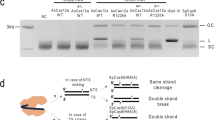Abstract
Bacterial RNA–directed Cas9 endonuclease is a versatile tool for site-specific genome modification in eukaryotes. Co-microinjection of mouse embryos with Cas9 mRNA and single guide RNAs induces on-target and off-target mutations that are transmissible to offspring. However, Cas9 nickase can be used to efficiently mutate genes without detectable damage at known off-target sites. This method is applicable for genome editing of any model organism and minimizes confounding problems of off-target mutations.


Similar content being viewed by others
References
Urnov, F.D., Rebar, E.J., Holmes, M.C., Zhang, H.S. & Gregory, P.D. Nat. Rev. Genet. 11, 636–646 (2010).
Joung, J.K. & Sander, J.D. Nat. Rev. Mol. Cell Biol. 14, 49–55 (2013).
Wiedenheft, B., Sternberg, S.H. & Doudna, J.A. Nature 482, 331–338 (2012).
Jinek, M. et al. Science 337, 816–821 (2012).
Cong, L. et al. Science 339, 819–823 (2013).
Mali, P. et al. Science 339, 823–826 (2013).
Hwang, W.Y. et al. Nat. Biotechnol. 31, 227–229 (2013).
Cho, S.W., Kim, S., Kim, J.M. & Kim, J.S. Nat. Biotechnol. 31, 230–232 (2013).
Jiang, W., Bikard, D., Cox, D., Zhang, F. & Marraffini, L.A. Nat. Biotechnol. 31, 233–239 (2013).
Jinek, M. et al. Elife 2, e00471 (2013).
Shen, B. et al. Cell Res. 23, 720–723 (2013).
Qi, L.S. et al. Cell 152, 1173–1183 (2013).
Wang, H. et al. Cell 153, 910–918 (2013).
Yang, H. et al. Cell 154, 1370–1379 (2013).
Fu, Y. et al. Nat. Biotechnol. 31, 822–826 (2013).
Hsu, P.D. et al. Nat. Biotechnol. 31, 827–832 (2013).
Mali, P. et al. Nat. Biotechnol. 31, 833–838 (2013).
Pattanayak, V. et al. Nat. Biotechnol. 31, 839–843 (2013).
Wang, J. et al. Genome Res. 22, 1316–1326 (2012).
Kim, E. et al. Genome Res. 22, 1327–1333 (2012).
Ran, F.A. et al. Cell 154, 1380–1389 (2013).
Yeh, S. et al. Proc. Natl. Acad. Sci. USA 99, 13498–13503 (2002).
Tesson, L. et al. Nat. Biotechnol. 29, 695–696 (2011).
Caldecott, K.W. Nat. Rev. Genet. 9, 619–631 (2008).
Rogakou, E.P., Boon, C., Redon, C. & Bonner, W.M. J. Cell Biol. 146, 905–916 (1999).
Quinlan, A.R. & Hall, I.M. Bioinformatics 26, 841–842 (2010).
Acknowledgements
We thank members of the entire Huang laboratory for their support and advice, G. Tischler for the C++ alignment code, and J. Liu and C. Gao for help with deep sequencing. This work was supported by grants from the 973 program (2010CB945101 and 2011CB944301) and a core grant from the Wellcome Trust.
Author information
Authors and Affiliations
Contributions
B.S., W.Z., J. Zhang, X.H. and W.C.S. designed the experiments and wrote the manuscript. B.S., W.Z., J. Zhang, J. Zhou, J.W. and L.C. performed the experiments. L.W., A.H. and V.I. performed the computational analysis of off-target sites.
Corresponding authors
Ethics declarations
Competing interests
The authors declare no competing financial interests.
Supplementary information
Supplementary Text and Figures
Supplementary Figures 1–10, Supplementary Tables 1–14 and Supplementary Note (PDF 3275 kb)
Supplementary Data
Paired off-target sites for AR-A and AR-B sgRNAs. Ten closest paired sites in the mouse genome with similar sequence to each combination of AR-A and AR-B Cas9 target sites. (XLS 92 kb)
Rights and permissions
About this article
Cite this article
Shen, B., Zhang, W., Zhang, J. et al. Efficient genome modification by CRISPR-Cas9 nickase with minimal off-target effects. Nat Methods 11, 399–402 (2014). https://doi.org/10.1038/nmeth.2857
Received:
Accepted:
Published:
Issue Date:
DOI: https://doi.org/10.1038/nmeth.2857
- Springer Nature America, Inc.
This article is cited by
-
Comprehensive review of CRISPR-based gene editing: mechanisms, challenges, and applications in cancer therapy
Molecular Cancer (2024)
-
Efficient and safe therapeutic use of paired Cas9-nickases for primary hyperoxaluria type 1
EMBO Molecular Medicine (2024)
-
A potential paradigm in CRISPR/Cas systems delivery: at the crossroad of microalgal gene editing and algal-mediated nanoparticles
Journal of Nanobiotechnology (2023)
-
Targeting RNA N6-methyladenosine to synergize with immune checkpoint therapy
Molecular Cancer (2023)
-
Generation of sheep with defined FecBB and TBXT mutations and porcine blastocysts with KCNJ5G151R/+ mutation using prime editing
BMC Genomics (2023)





